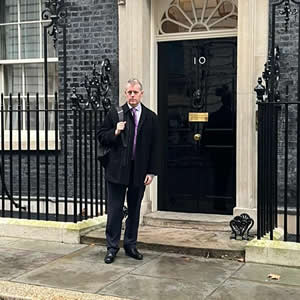What are you doing on Saturday?

December and January have been particularly torrid. An early and unexpected Group A Strep outbreak resulted in huge pressure on paediatric areas, and then the predictable ‘twindemic’ of flu and COVID resulted in extraordinary exit block and hideous crowding. The RCEM media machine turned on and we were vocal and consistent that the situation was extremely dangerous for our patients and harmful for us. We nailed our colours to the mast and asserted that long waits are associated with mortality, and that we thought problems accessing emergency care were contributing to the persistently high excess mortality. We have previously stated this, but reminding people never hurts.
I said this on the Radio 4 Today Program and was rebutted by some senior NHSE spokesmen. I was pleased the next day to be supported by Professor Sir David Spiegelhalter, an eminent statistician at Cambridge University. Practically, quibbling over the data and the methods is a distraction when the visible harms are so visible. There was a media storm, and many of us will have been pleased to see Higgi, Salwa, Maya and Jason consistently and effectively getting our message across. Suddenly all sorts of doors opened up. I was invited to meet the Secretary of State at eight hour’s notice who was interested and attentive to our recommendations.
After a long clinical day, I then was phoned by Professor Steve Powis, the Medical Director of NHS England.
‘Hi Adrian, what are you doing on Saturday?’
‘Dunno, walking the dog and thinking about going to the gym, why?’
‘You’ve been invited to go to 10 Downing Street to take part in a NHS crisis summit, can you go? You will need to submit evidence’
‘Err, yes the dog can walk herself’
There was then a frantic day for the policy team to prepare an evidence submission against a tight deadline. I drove down to London, as the strikes had stopped all trains. I hoped my daughter’s ‘L’ plates on the car were not a bad omen.
I cannot tell you who was at the meeting, but we were among only a few Royal Colleges that were invited. The summit was organised into four sessions; social care, UEC, elective backlog and primary care. We were in UEC only. I sat between Chris Witty and Will Quince.
It was a big meeting, we were invited to present directly after the Prime Minister’s opening remarks. The PM had our evidence submission and had scribbled notes all over it and highlighted certain points. He referred back to it a number of times.
I was able to land some, but certainly not all of my points. I was supported by Chris Witty who was a great ally. I put a pin into pre-ED cohort areas and demand management strategies. I think I got across that the problems around ambulance handover delays are intimately related to exit block, beds capacity and social care, I was also able to get across that all triage services (111, GP and 999) all work better where there is clinical involvement. There was interest in continous flow models, but I caveated that this isn’t a silver bullet and poor least worst option. There was a lot of discussion about risk sharing, but mainly about where this is with frail patients. Again, I caveated that risk sharing is often uneven but concentrated in ambulance, ED but less in admission and discharge from inpatient beds. I raised litigation and GMC. Our points about evaluating any initiative landed well. I got the impression that the Treasury gets asked to sign cheques with no idea whether something is effective and demonstration of benefit is critical.
It was not all plain sailing, there was little discussion about metrics or workforce, but this is a conversation for another day. I know conversations about pensions, for instance, happened elsewhere.
It was an extraordinary day and I really hope that this leads to improvements and changes. However, words and meetings have to lead to actions.
For interest, I have pasted our evidence submission below.
NHS Recovery Forum at 10 Downing Street (Jan 2023)
What do we need to do to nationally and locally to create a step change in ambulance and A&E performance across the whole country?
The Urgent and Emergency Care (UEC) system supports a significant number of patients with a huge variety of medical conditions and social problems, ranging from acute emergencies and trauma to acute mental health crises, and the care of homeless, and elderly patients. Emergency Departments (EDs) are by their nature dynamic, providing responsive care to those who need it and an essential front-line service available 24 hours a day, seven days a week. Very few people plan to visit an ED, yet everyone is a potential patient. Performance figures for November 2022 reveal that there were 38,000 12-hour stays from decision to admit – the second highest figure on record – and the four-hour target stood at 54.5%.[1] This signals that the emergency care service is unable to provide responsive and safe care to patients with the current level of resource.
ED attendances can provide useful measures of overall demand for emergency care. The graph above shows that attendances to type 3 services remain below pre-pandemic levels and attendances to all forms of emergency service have remained static over the past few months. NHS England recently reported that over the last five to seven years the percentage of patients attending an ED with more than three long-term conditions has risen from 10% to 30%.[2] Patients who are stuck in crowded corridors require admission cannot be redirected to a GP, urgent treatment centre, or able to care for their own medical needs through an online or telephone service. There is little evidence to suggest that solutions aimed at managing demand to EDs will improve crowding. This briefing will outline short term measures to support the system to ensure it can provide a responsive service to all emergency patients.
Theme 1: Improve patient flow through the hospital
Recommendation: aim to increase the number of staffed beds in hospitals. The NHS in the UK has fewer beds per capita than most comparable OECD nations.[3] RCEM’s Beds in the NHS report recommended an additional 3,500 additional staffed hospital beds to be opened for Winter 2022/23.[4] In the medium-to long term we called for an additional 10,300 staffed beds across England. NHSE aimed to open 7000 extra beds across hospital, community and virtual setting this winter. In hospital settings, there have been an increase of 1,649 type 1 General and Acute beds since September 2022. A recent study revealed that 1% increase in bed occupancy was associated with a 9.5 percentage point decrease in a Trusts’ probability of meeting the four-hour target, and an approximately six patient increase in four hour to 12 hour waits from decision to admit per 1,000 admissions.[5]
Recommendation: prioritise the discharge of patients who are medically fit to leave the hospital by utilising independent sector care home capacity and distributing the discharge funding. NHSE situation reports revealed that, in the last week in December, the average number of patients remaining in hospital while no longer meeting the criteria to reside was 12,674, 7.47% lower than the previous week where the figure was 13,697. On average, 56.9% of patients who no longer met the criteria to reside remained in hospital, down from 60.6% the previous week. In week 6 of 2021, this figure was 53.2%.
Recommendation: roll out the continuous flow model across most acute hospitals This model mandates that patients are moved at from EDs to inpatient wards, regardless of whether a bed is available. This model offers a way to share risk, as well as a mechanism to make manage beds more effectively and support the flow of patients through the hospital system. There are a number of before and after studies which suggests this improves ambulance performance and supports short waiting times in EDs.[6]
Recommendation: Incentivise use of Same Day Emergency Care (SDEC) so it is available 12 hours a day, seven days a week. SDEC services improve the quality of care and staff morale, are cost effective, and reduce avoidable admission into hospital. Modelling from NHS England reveals a 30% reduction in waiting times for SDEC patients and a 3-18% reduction in waiting times for non-SDEC admitted patients.[7] Yet our snapshot survey of 70 clinical leads, carried out in November 2021 found that only 10% reported SDEC being available 12 hours a day 7 days a week in their EDs.[8]
Recommendation: Increase clinical input into NHS 111. This will not tackle crowding but will ensure that patients are likely to be directed to appropriate healthcare settings. The proportion of calls that are ‘clinically validated’ must be significantly increased by recruiting more clinicians to work for NHS 111. In 2021/22, 50.9% of calls were assessed by a clinician or clinical advisor.[9] The CQC’s state of care report found that where NHS 111 made additional use of midwives, mental health practitioners and pharmacists, they could give more appropriate clinical advice to patients, supporting local systems to redirect patients.[10] An study of paediatric clinicians working in NHS 111 revealed it is likely to increase self-care dispositions, and reduce onward referrals to primary care, ED and ambulances. Disposition rates differed significantly between the calls taken by paediatric versus (vs) non-paediatric clinicians: 69% vs 43% were advised on self-care only, 13% vs 18% to attend EDs, and 1% vs 4% to receive an urgent ambulance call out.[11]
Theme 2: Meaningful, evidence-based metrics that drive performance, ensure patient safety and maximise efficiency.
Recommendation: Ensure there is clarity around the 76% four-hour target. Due to the uncertainty around the future of the four-hour standard and the Clinical Review of Standards (CRS), the UEC system in England has been operating in a performance vacuum. We welcome clarity around the performance management regime of emergency care. However, we have concerns that with a four-hour target as low as 76%, hospitals will be incentivised to quickly process minor patients, allowing them to meet the target, neglecting the patients most at risk of harm.
Recommendation: Reinstate the publication of the performance metrics of the 14 CRS pilot sites. In May 2019 the 14 trusts selected to take part in the CRS pilot paused the monthly publication of their four-hour target. New analysis reveals that these Trusts reported worse average waiting times for admitted patients than those which stayed on the four-hour target.[12] These trusts have not reported their four-hour performance data since then. The pilot site data must be reinstated for the sake of transparency and to support the performance management of these EDs.
Recommendation: Disaggregate performance figures to provide transparency and better opportunities for benchmarking. The patient experience of those that are admitted versus patients that do not require admission, and those that access healthcare via a type 1 department or a type 3 department, vary greatly. At present, the monthly performance data is published in an aggregate format. However, disaggregating the data by these patient groups would provide greater transparency and better opportunities for benchmarking, ensuring that resource is distributed in the most efficient way. Data from Northern Ireland demonstrates how disaggregating the data can paint a clearer picture of where the issues lie. During September 2022, the median time patients admitted to hospital spent in ED was 13 hours 19 minutes, compared to 3 hours 14 minutes for those discharged home.[13] Additionally, the graph below on the left shows four-hour performance broken up by Type 1 EDs and all departments. Detailed disaggregated data enables hospitals to focus on providing care to the sickest patients.
Recommendation: Routinely publish the numbers of patients waiting 12 hours or more from their time of arrival (ToA). We have long argued that the current way in which the 12-hour metric is measured and published – from the decision to admit (DTA) – is misleading and unhelpful for clinicians. Publication of the 12-hour data from ToA is patient-centred and will bring about greater accountability in the entire health and social care system. This will help us, NHS England, Trusts, and Integrated Care Systems to better understand the extent of crowding, long stays and corridor care taking place in our EDs by elucidating unwarranted variation, that is not as apparent in the DTA data. The graph below shows the relationship between high proportion of 12-hour ToA waits, and poor performance against the four-hour metric. It is interesting to note that the last time that four-hour performance stood at 76.5% in May 2021, 2.26% of patients waited 12 hours or more from their time of arrival.[14] As of, October 2022, this figure stood at 12.1%.[15] Finally, better quality data will reduce bureaucracy and time spent judging 12-hour decision to admit breaches.
Theme 3: Improve recruitment and retention in EDs
Recommendation: Publish a detailed workforce strategy with a clear expansion plan, aiming for one FTE consultant per 4000 annual attendances. The workforce in EDs is experiencing significant rates of burnout and morale injury due to operational pressures, further exacerbated by a lack of sufficient staff. Most importantly however, the lack of workforce is a risk to patient safety. To safely staff departments, there should be one full-time equivalent (FTE) consultant for every 4000 annual attendances yet in England this figure stands at 1:7000. The intensity of the work coupled with pension penalties has resulted in an increasing number of staff deciding to drop their hours, or even retire early. We recently conducted a workforce census in Wales that revealed a fifth of the EM consultant workforce plan to retire in the next six years. Furthermore, in Wales, 13.6% of funded consultant posts were not filled due to a lack of candidates to take up the job and it is likely that the picture is similar in England.[16] Furthermore, departments are haemorrhaging nursing staff who play a vital role in the safe delivery of care. A study from NHS England revealed that EDs with high numbers of admissions per registered nurse struggled to deal with their demand effectively, leaving them with poor patient flow.[17] An aggressive retention strategy is urgently required to retain nursing staff. For EM staff, there is no end in sight, currently no comprehensive workforce plan to deliver them hope, and no resolution to the pension’s issue. Good recommendations about staff wellbeing are described in the PIPP project.
Conclusion
Long waiting times in EDs can be a matter of life and death.[18] This can mean that recovery is less complete than it need be, affecting all aspects of life, including the ability to work. It is important to understand what works and what doesn’t when introducing new initiatives to tackle long waits. New interventions should always be measured and evaluated, and this evidence used to amend and inform the design of policies. Although there is often a lengthy process to publish academic reports, NHS England has a mechanism to provide quick and useful evaluations through the Midlands Decision Support Network (formerly the West Midlands Strategy Unit).
[1] RCEM Data & Statistics
[2] House of Lords, Public Service Committee, Access to Emergency Services
[3] OECD Data, Hospital Beds
[4] RCEM (2022) Beds in the NHS
[5] Friebel & Juarez (2020) Spill Over Effects of Inpatient Bed Capacity on Accident and Emergency Performance in England. Health Policy, 124:11. 1182-1191
[6] Viccellio A, Santora C, Singer AJ, Thode HC, JrHenry MC. The association between transfer of emergency department boarders to inpatient hallways and mortality: a 4-year experience. Ann Emerg Med 2009 ;54:-91
P, Zito JA, Sayage V, etal. Patients overwhelmingly prefer inpatient boarding to emergency department boarding. J Emerg Med 2013 ;45
Alishahi Tabriz A, Trogdon JG, Fried BJ. Association between adopting emergency department crowding interventions and emergency departments ’ core performance measures. Am J Emerg Med
Lee MO, Arthofer R, Callagy P, etal. Patient safety and quality outcomes for ED patients admitted to alternative care area inpatient beds. Am J Emerg Med 2020 ;38:- 7.
[7] NHS England (2021) Getting It Right First Time Emergency Medicine Report.
[8] RCEM (2021) Snapshot Survey 5. December 2021
[9] Integrated Urgent Care Aggregate Data Collection
[10] CQC (2022) The state of health care and adult social care in England 2021/22
[11] Stilwell PA, Stuttard G, Scott-Jupp R, et alPaediatric NHS 111 Clinical Assessment Services pilot: an observational studyArchives of Disease in Childhood 2022;107:e14.
[12] Health Service Journal (2022) Waiting times got worse at trusts that dropped A&E target
[13] Emergency Care Waiting Time Statistics July – September 2022, NI Department of Health
[14] RCEM Data & Statistics
[15] RCEM Data & Statistics
[16] Forthcoming RCEM publication, 19th January 2023
[17] GIRFT Programme National Specialty Report (2021) Available: here
[18] Jones S, Moulton C, Swift S, et al. Emerg Med J Epub (2021) Available: here


0 Comments